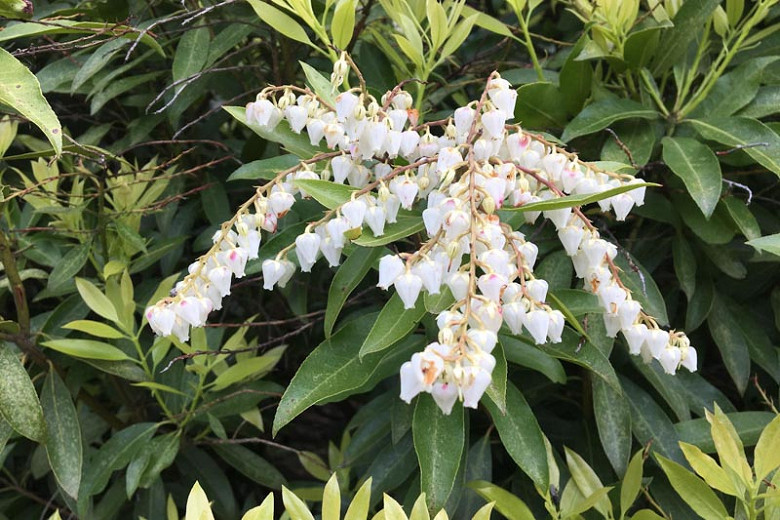[ad_1]
Legend has it that Cassiopeia, an ancient queen of Ethiopia, bragged to Poseidon, god of the sea, that her daughter, Andromeda, was more beautiful than Poseidon’s sea nymphs. Poseidon was touchy about such things and punished Cassiopeia by sending a sea monster to terrorize the Ethiopians. Eventually, the Ethiopian rulers consulted oracles who told them that Andromeda had to be sacrificed to the monster in order to save the country. Fortunately for Andromeda, the great hero Perseus happened by and saw her chained to a rock awaiting her fate. He rescued her, killed the monster, and after a few more trials and tribulations, the couple married. They had several children and were eventually rewarded for their virtue by being placed in the night sky among the constellations.

Andromeda also ended up as a shrub, so to speak, and a good one at that. At this time of the year, you see white-flowered Andromeda, also known as Pieris, blooming in every other yard.
The most common Pieris, Pieris japonica, are, as the name suggests, natives of Japan. They are also known as lily-of-the-valley shrubs because of their small bell-like blossoms. Pieris flowers are borne in racemes or clusters at the ends of the branches. While not as spectacular as those of many azaleas, rhododendrons or hydrangeas, they are lovely in a subtle way and smell just like honey.
Pieris are especially desirable because they are all evergreen and many of them provide visual interest in more than one season. The elongated oval leaves are dark green and glossy, and in some cultivars, the young foliage emerges red or bronze, which is downright exciting in the spring. The shrubs thrive in the acid soil that abounds in many areas, and once they are established are not fussy about care. If you are looking for a shrub that is familiar but different, some of the hybrid Pieris fill the bill nicely.
Many of the Pieris on the market are either native Asian species or their descendants. Because the shrubs are so useful, they have also been hybridized extensively. There are many good Dutch and Japanese hybrids, as well as some excellent cultivars developed by an American, Dr. Robert Ticknor, at the North Willamette Research and Extension Center in Oregon.
Pieris ‘Forest Flame’ is a medium size (maturing to five feet) variety that has brilliant red early growth. The color and pattern of the new leaves is such that from even a short distance the red leaves appear almost poinsettia-like. After a while, the leaves mature to pink, then cream, then finally to green. It’s rare to find a plant that does all that without even bringing flowers into the picture. Pieris japonica ‘Variegata’ has the same bright young foliage, but when the leaves mature they are edged in cream.
There are those demanding gardeners, of course, who will think that fragrant white flowers, and brilliant leaves and even variegation just doesn’t do enough. For them, there are Pieris with red or pink or even bi-colored blossoms. ‘Dorothy Wycoff’ features eye-catching dark purplish-red flower buds that open in the spring to reveal pink bells. This cultivar also supplies winter interest because the leaves turn bronze and remain so during the cold months. If pink is anathema in your garden, but red is acceptable, try Pieris japonica ‘Shojo’, which has deep red flowers. Fans of bi-color blossoms should try Pieris ‘Christmas Cheer. While it doesn’t bloom at Christmas, it definitely brings a gift to the garden. The flowers are white with rosy edges.
There are also Pieris for small-space gardeners. The smaller cultivars can be grown in pots on a terrace or deck, or used in ornamental borders. One of the japonicas, Pieris japonica yakusimana, grows only 1-2-feet tall but has the same large clusters of white flowers produced by much larger cultivars. For the middle of the border or a large pot, Pieris japonica ‘Pygmaea’ grows to about 3-feet tall, and has the same white flowers and brilliant red spring foliage as other varieties.
The cultural requirements for Pieris are similar to those for rhododendrons. In addition to acid soil, the plants thrive best in light shade. For a sunnier location, try a sun-tolerant hybrid, Pieris ‘Mountain Fire’. As the name suggests, the spring growth is bright red. The flowers are white.
The mythical Andromeda started out as an unlucky young woman—sacrificed because of her mother’s vanity and the unpredictable wrath of the gods. She ended up with a heroic husband, a kingdom, a constellation, and a namesake plant that is universally admired. It almost makes up for the sea monster.
Common Pieris varieties can be found in most nurseries and garden centers.
Yellow Rose
SWORD LILIES
CHANGE IN THE GARDEN
UNFORGETTABLE
FRESH VEGGIES
[ad_2]
Source link








 + Planting String of Watermelon Succulents
+ Planting String of Watermelon Succulents  with Garden Answer
with Garden Answer


